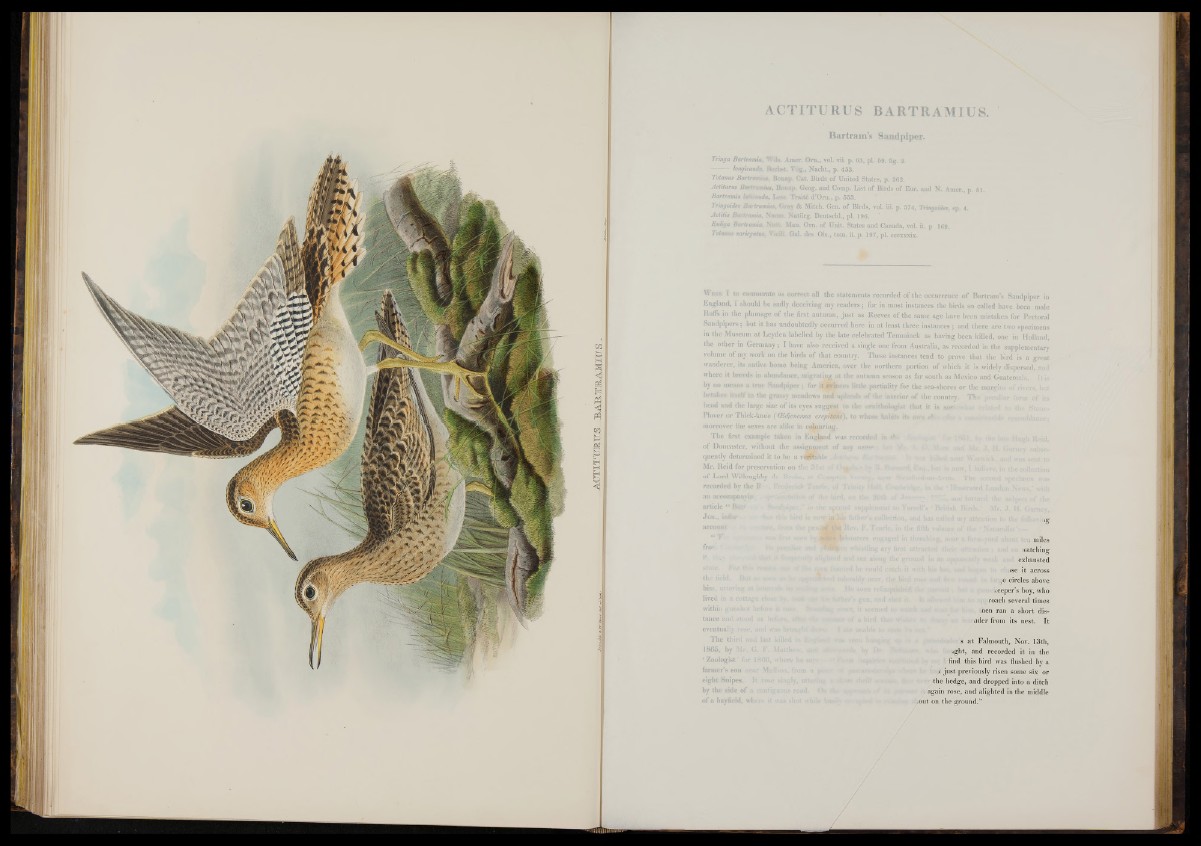
ACTITUßHS BAÄTRAMIUS .
ACTITURUS BARTRAMIUS.
Bartram’s Sandpiper.
Tringa Bartramia, Wils. Amer. Orn„ vol. vii. p. 63, pl. 69. fig.
longicauds. Rechst. Vög., Nacht., p. 453.
Totanus Bartratm», Bonap. Cat. Birds, of United States, p. 262.
Actiturus Barttammy Bonap. Geog. and Comp. List of Birds of Eur. and N. Amer., p. 51.
Bartramia laikmda, La»». Traité d’Orn., p. 553.
IHngoide» Bartramm, Gray & Mitch. Gen. of Birds, vol. iii. p. 574, Tringoides, sp. 4.
Actitis Bartramia, Naum. Natiirg. Deutschl., pl. 196.
Euiiga Bartramia, Naît. Man. Om. of Unit. States and Canada, vol. ii. p 169.
Totaam variegatwt, Viéüi. Gal. des Ois., tom. ii. p. 197, pl. cccxxxix.
W erk 1 to enumerate as correct all the statements recorded of the occurrence o f Bartram’s Sandpiper in
England, I should be sadly deceiving my read ers; for in most instances the birds so called have been male
Ruffs in the plumage o f the first autumn, ju st as Reeves of the same age have been mistaken for Pectoral
Sandpipers; but it has undoubtedly occurred here in a t least three instances ; and there are two specimens
in the Museum at Leyden labelled by the late celebrated Temminck as having been killed, one in Holland,
the other in Germany; I have also received a single one from Australia, as recorded in the supplementary
volume o f my work on the birds o f that country. These instances tend to prove that the bird is a great
wanderer, its native home being America, over the northern portion of which it is widely dispersed, and
where it breeds in abundance, migrating a t the autumn season as far south as Mexico and Guatemala. It is
by no mean« a true Sandpiper; for itevin.w, little partiality for the sea-shores or the margins of rivers, but
betakes itself So the grassy meadows and uplands of the interior o f the country. The peculiar form o f its
head and the large size of its eyes suggest to the ornithologist that it is acHr*; =»a.m r *,> th(* Stone*
Plover or Thick-knee ( (Edicnemus crepitans), to whose habits its own A"
moreover the sexes are alike in colouring.
The first example taken in England was recorded in *#w
o f Doncaster, without the assignment o f any nswyf
quently determined it to be a vmtabb-
Mr. Reid for preservation on the 31st of Oi*i>W
o f Lord Willoughby de Broke, at C
recorded by the B . Frederick Tearle, of Trinity ¡•’•¡•‘i. C&mhridge. »», the • Illustrated London Now* ’ with
an accomp&nvm
article “ Sandpiper,'"'u» tin? second supplement to Yarrelfs * British Birds.’ Mr. J . H Gurney
Jun., infer this bird is now in lib father's collection, and has called my attention to the following
account
t ten miles
on watching
nd exhausted
• d >use it across
— e circles above
;i.ekeeper’s boy, who
: roach several times
'o, then ran a short dis-
' . ruder from its nest. It
eventually rose, and was brtongb
nh-r.'s a t Falmouth, Nov. 13th,
ught, and recorded it in the
■_ I/find this bird was flushed by a
HHfl ju st previously risen some six or
the hedge, and dropped into a ditch
> u/again rose, and alighted in the middle
v tbout on the ground.”